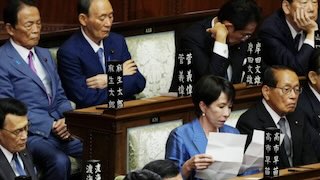TOKYO, Oct 10 (News On Japan) - Japan’s new administration under Liberal Democratic Party President Takaichi faces its first major diplomatic test: an inaugural summit with President Trump, expected on October 28. How that meeting unfolds—and how Takaichi responds if Trump presses Japan to lift defense outlays to 3.5% of GDP—will shape Tokyo’s security posture. With Beijing wary of Takaichi’s stance, the trajectory of Japan–China relations is also in focus.
On a current-affairs program, commentators noted how leaders worldwide have handled Trump—above all by showing respect plainly and, at times, effusively. Past examples included warm praise from Japanese leaders, outreach by South Korea’s president, and Europe’s attempts to frame Trump’s blunt rhetoric as a tool to stop “fights.” Finland’s president famously logged seven hours of golf with Trump, while Italy’s Meloni has lauded his toughness.
Guests stressed that Takaichi should balance directness with care not to flatly negate Trump’s assertions. Building “chemistry” matters: both sides’ ties to the late Abe, a right-leaning outlook, and an unscripted speaking style could help. But Trump tends to value counterparts who command firm domestic support. Abe’s repeated election wins underpinned his standing with Trump; Takaichi will be judged on whether she can consolidate her base at home.
Attention is fixed on possible U.S. demands to boost Japan’s defense spending. NATO leaders in June agreed to raise aggregate defense investment to 5% of GDP by 2035—3.5% for core military outlays such as equipment and 1.5% for infrastructure and cyber resilience. Analysts warned that Washington is likely to treat 3.5% as “real” defense spending and press U.S. allies in both Europe and Asia to meet similar thresholds, with the additional 1.5% on top. Japan’s current level, including the Coast Guard and dual-use airport and port upgrades, is about 1.8% of GDP.
Takaichi has said the government will “build up necessary costs carefully and respond,” signaling openness to increases without committing to a figure. Former Pentagon advisers cautioned that Trump and the Department of Defense often view defense budgets as the central measure of allied contribution, giving little credit for areas where Japan has long been active, such as development aid and multilateral funding. A jump to 3.5% would imply roughly 15 trillion yen a year—an amount that could fundamentally alter the division of roles in the alliance. Japan must explain that such levels would reshape force planning and the U.S. presence in Japan.
Some argued for reframing: counting investments in industrial resilience, research and development, and next-generation capabilities as part of a broader defense-strengthening package—while recognizing the U.S. will insist that the 3.5% core be devoted to strictly military spending. Infrastructure like hardened shelters, medical networks, transport corridors, and cyber defenses—areas that have lagged—should be prioritized within the wider 5% concept, they said.
Timing and diplomacy will matter. NATO’s 5% framework includes a 2029 review—the same year Trump’s second term, if served in full, would end—leaving scope for recalibration. Experts also noted that allied leaders who met Trump recently avoided on-the-spot wrangles over host-nation support and headline defense ratios by foregrounding personal rapport and broader cooperation.
China policy presents a second major test. Beijing views Takaichi as the least preferred of the LDP leadership contenders and is watching three issues closely: visits to Yasukuni Shrine, Taiwan engagement, and key cabinet and staff appointments. Takaichi previously said she would decide on Yasukuni “as appropriate” if prime minister. Her April visit to Taiwan and remarks at the Hudson Institute—emphasizing that peace and stability in the Taiwan Strait are vital to Japan and the international community—have drawn Chinese scrutiny. Scholars in China warned that repeated prime-ministerial visits to Yasukuni or appointments seen as hard-line would lower the odds of a Japan–China leaders’ meeting at APEC later this month.
Analysts urged Tokyo to sustain deterrence while avoiding unnecessary provocations, broaden channels with Beijing, and not assume Washington will always counterbalance China in Asia. They see a non-zero risk that a U.S.–China understanding on trade or hemispheric priorities could leave Japan managing sharper tensions with China largely on its own. That argues for steady alliance coordination, frequent direct contact with Trump—including at ASEAN-related meetings and APEC—and a clear Japanese agenda that plays to U.S. priorities such as conflict stabilization and reconstruction in Gaza and Ukraine.
The consensus: Takaichi’s immediate task is to anchor personal trust with Trump, present a credible, built-from-needs defense plan, and keep options open with Beijing. The coming weeks—spanning the summit expected on October 28 and a string of regional meetings—will quickly reveal whether “Takaichi diplomacy” can turn early headwinds into leverage.
Source: TBS















